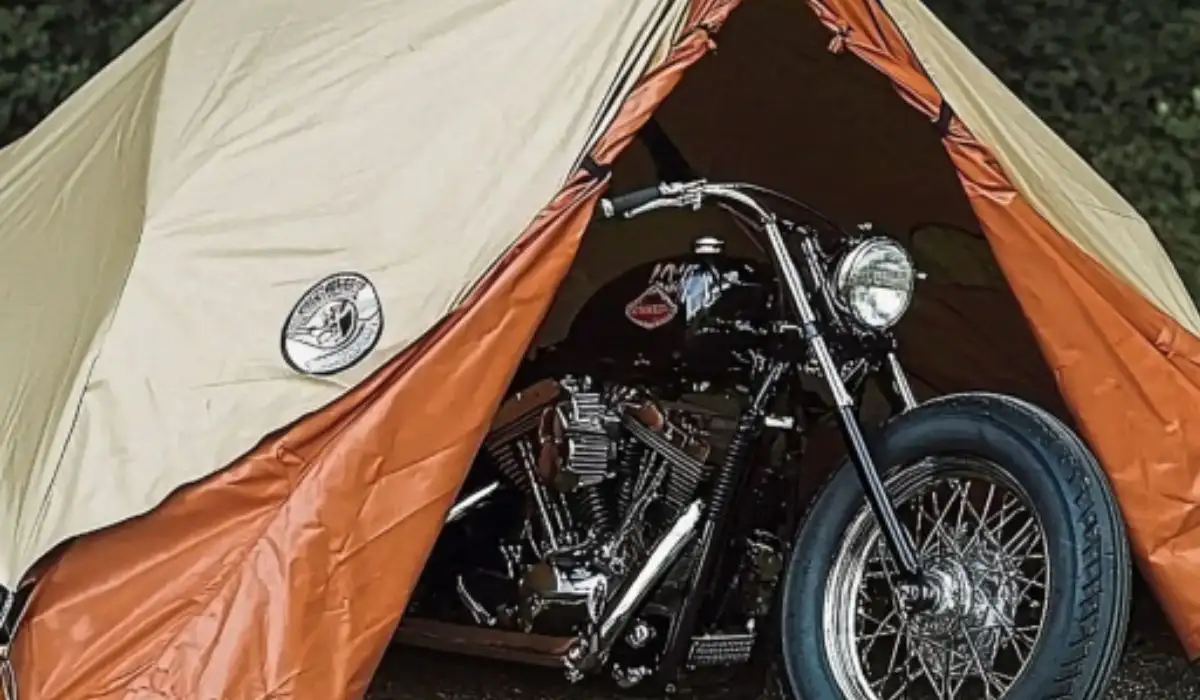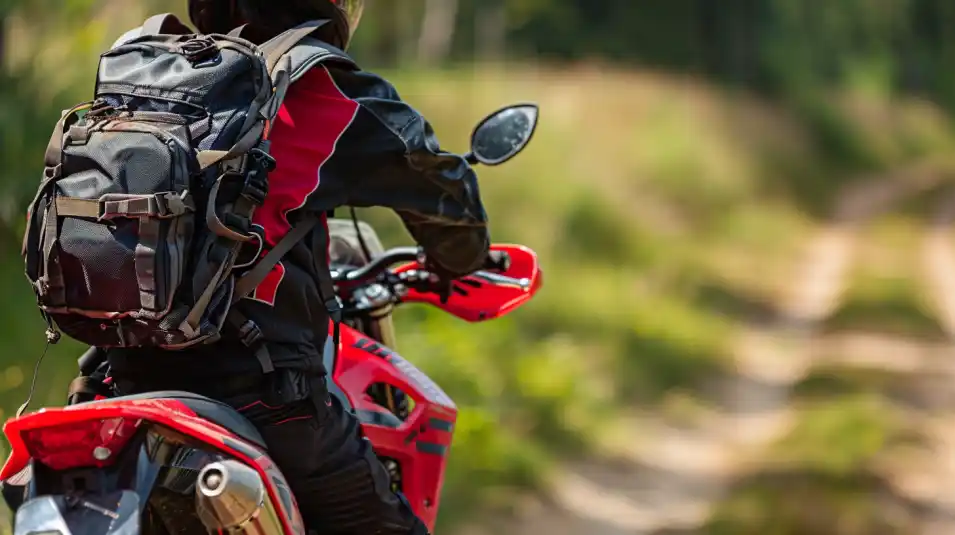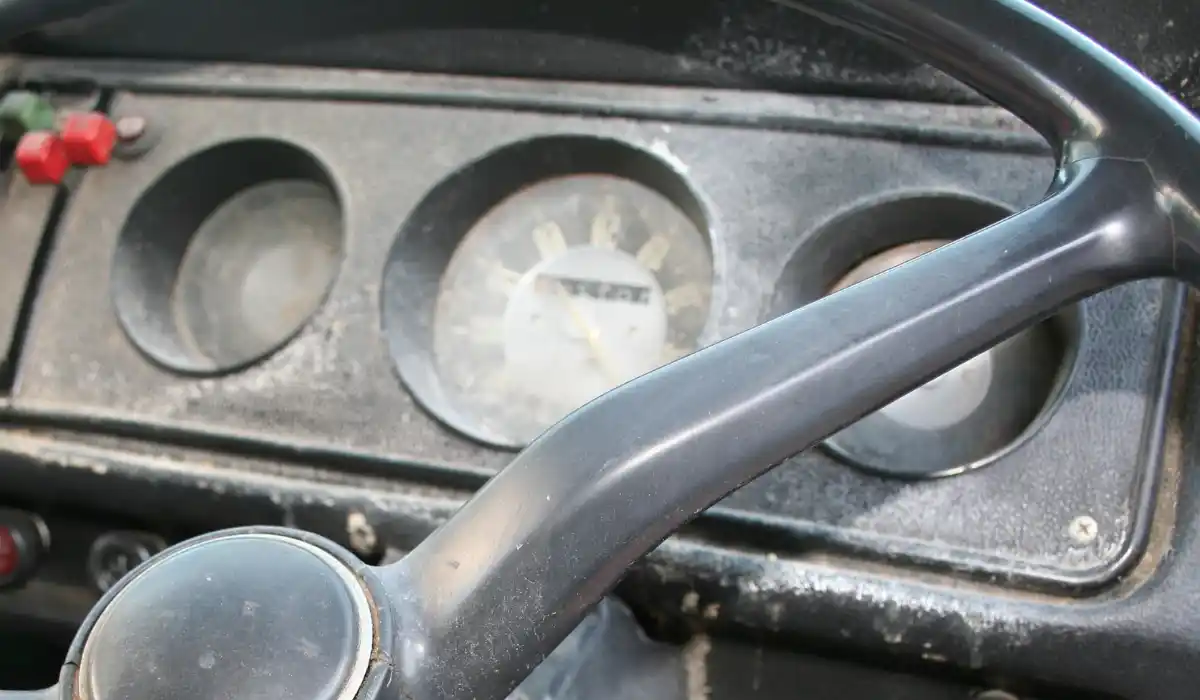
There’s no doubting it – you’re definitely going to make mistakes when you first start riding a motorcycle. These common motorcycle mistakes are made by everybody – so don’t be embarrassed when something happens to you.
Even after a weekend at your motorcycle safety course, you’ll barely know how to ride. Making mistakes is how you’ll turn from a beginner rider into a seasoned pro. When, not if, something goes wrong just laugh about it and keep riding.
Everybody starts out not knowing how to ride. In this post, let’s take a look at the most common motorcycle mistakes you could make. This way you’ll be best prepared for when something happens and you’re on the road.
Jump Ahead To:
Common Motorcycle Mistakes Made By Beginner Riders
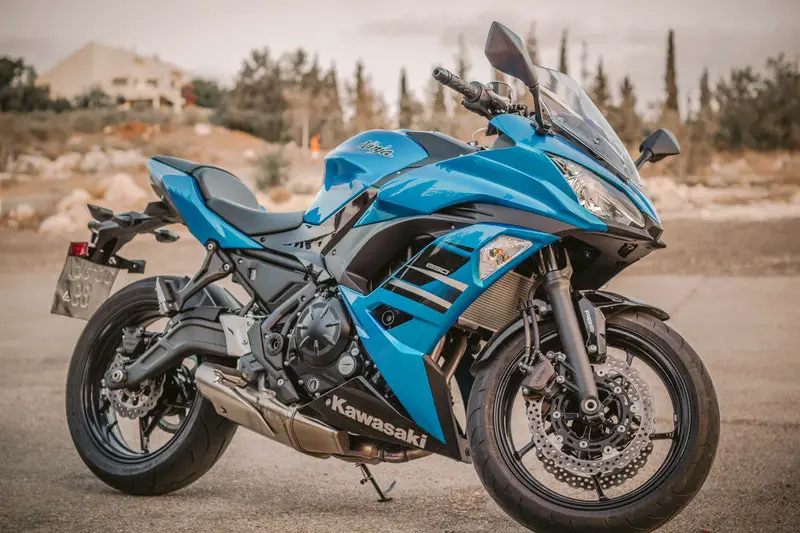
1. Stalling the Motorcycle
On my first ride after buying my 2011 Honda CBR250R I stalled more than 30 times. Yes – you read that right! At almost every stop sign or stop light I would let the clutch out too fast or not given enough throttle.
The result? Stalling the bike dozens of times before I figured it out. It wasn’t until a few days later that the majority of my stalls are behind me. I remember it happening after about a month of riding – it was such a comical situation that I burst into laughter about it.
Stalling happens because you’re letting out the clutch too fast, holding the clutch in for too long, or not giving enough throttle. Power gets cut to the engine and the bike stalls out.
It’s embarrassing at the time, especially when there’s people around or you’re in traffic. Thankfully, there’s nothing wrong with stalling and it’s not going to damage your motorcycle. After it happens, quickly start your bike and get going!
The more you ride the more familiar you’ll become with how the clutch on your motorcycle works. Eventually you’ll be quick shifting and reminiscing about the days that you used to stall.
When it comes to the clutch, it’s all about the friction zone. Practice finding the friction zone in a parking lot or quiet side street. Once you learn where it is and how much throttle to give you’ll be ready to rip.
2. Forgetting to Cancel Your Turn Signals

This still happens to me even after a year of riding. Forgetting to cancel your turn signals is a common beginner motorcycle rider mistake. Once you start riding you’ll start seeing it happen to beginners and long-term riders alike.
Some motorcycles are equipped with self-cancelling signals, though this isn’t common. In a car the turn signal is automatically cancelled once the turn is complete. This isn’t the case with motorcycles where you have manual control over the signals.
It’s not a big deal to forget turning the signal off. You might be annoying the people behind you, but it’s not dangerous in any serious way.
This is a mistake you’ll make a lot when you first start riding. Eventually you’ll remember to turn off the signal after completing your turn. Even when you do forget, it’s not a big deal.
Try to look down at your display regularly and keep an eye out for the blinking signal light. Always turn it off right away if you notice the signal is still on and you’re not making a turn.
3. Not Wearing Protective Gear
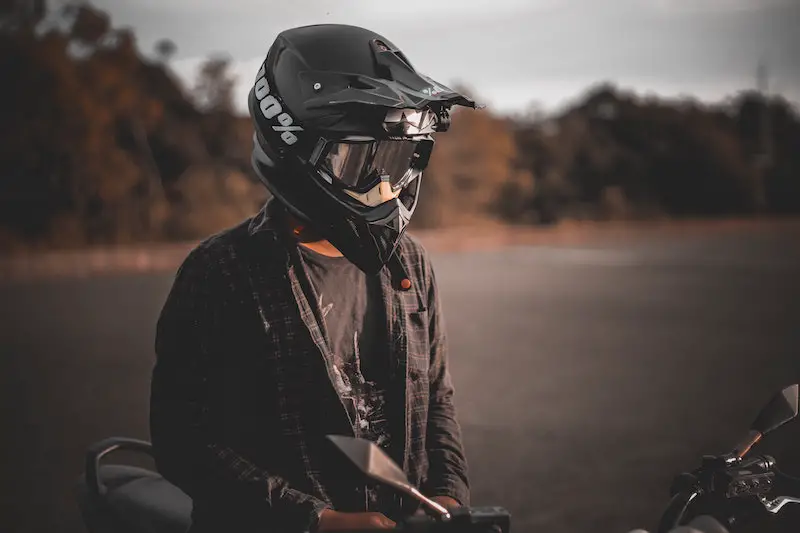
This isn’t something that can be learned and it’s not a mistake you want to learn from. Some new or inexperienced riders think they can get away with not wearing protective gear on every ride.
You’ll definitely want to invest in riding gear before ever hopping onto your motorcycle for the first time. If you’re just getting started, check out the amazing selection of gear at Viking Cycle. Here you’ll find a wide range of fashionable and affordable motorcycle gear to protect you when you’re out on the bike.
While you might be fine at first, it only takes one small mistake that’ll make you regret not wearing your gear. Motorcycle protective gear includes a motorcycle helmet, motorcycle gloves, pants or jeans, motorcycle riding boots and a motorcycle jacket.
Check out our helpful motorcycle gear guide for more information.
This is the gear you need to invest in before you start riding. It’s all that protects you from the road and other cars or objects should something go wrong.
Seeing people ride without helmets, wearing shorts and sandals, or riding in a T-shirt is mind-blowing to me. Without the right gear your skin will get ripped off and you’ll suffer serious injuries if you get into a motorcycle accident or tossed from the bike.
At the bare minimum, a helmet and motorcycle jacket should be worn. There are plenty of options for gear suitable for all riding seasons. There’s no excuse not to ride fully protected.
4. Not Downshifting Before Stopping

This is another mistake that I still sometimes make when I’m out riding. Forgetting to downshift before stopping can stall your bike. It’s dangerous to be stuck in the wrong gear in traffic.
This is something you’ll learn as you gain experience riding. It still happens to the best of us and it’s annoying depending on what gear you’re in.
Forgetting to shift from second gear isn’t a big deal. Most bikes can get going in second gear. Getting stuck in fourth or fifth gear could be a problem. It’s not easy to cycle through the gears when you’re stopped and traffic is waiting behind you.
When this happens you have two options. Roll the bike backwards or forwards and shift through the gears into first. Alternatively, pull over to the side and shift the gears when it’s safe.
This is a mistake that all riders make. There are tons of distractions on the road and sometimes you just forget to downshift. It’s not a big deal, just take care of it right away to avoid any problems.
5. Dropping the Motorcycle
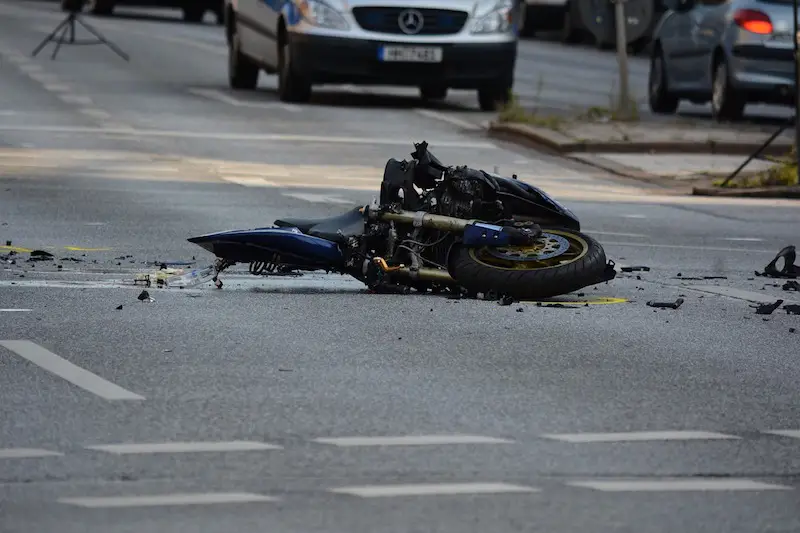
Everybody drops their motorcycle at least once. If they say otherwise, they’re either a wizard or not telling the truth.
Forgetting to put down the kickstand is the most common motorcycle mistake that leads to a dropped bike. The other mistake is losing balance at a light or while cruising at slow speed.
It’s not a big deal to drop your motorcycle. Sure, it’s embarrassing and you might break off a mirror or turn signal. Apart from that, your bike will most likely be fine and ready to keep going.
When you drop your motorcycle make sure to pick it up using the proper methods. You don’t want to hurt your back or not be able to lift the bike off the ground.
After dropping the bike give it a quick inspection to see what’s damaged or broken. It’s a good idea to pick it up as soon as possible to avoid any leaking fluids.
Parking the bike improperly can also lead to it being tipped over or dropped. Always park on flat, level ground. The mistake I made once was parking the bike on wood chips and turning my back to it. There was a big thunk and I looked back to see my bike laying on the ground!
There are kickstand pads available for parking on soft ground or gravel. If you do have to park on a hill, leave the bike in gear facing uphill with the slope on the kickstand side.
6. Running Out of Fuel
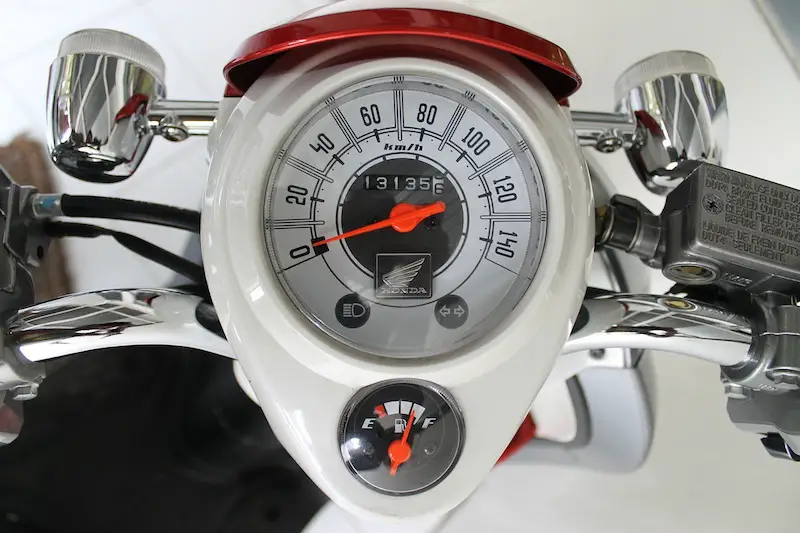
Depending on the motorcycle you have there might not be a fuel gauge. This makes it possible and surprisingly easy to run out of fuel while you’re riding. It’s not a big deal to run out of gas, just a pain in the butt.
Without a fuel gauge you’ll have to keep track of your fuel level. Once you start riding you’ll get a better idea for how far your bike can go before it’s time to fuel up.
After fuelling, reset the odometer. Write down or make a mental note of the distance traveled the next time you get fuel. This will give you an average of how far you can ride before you need to visit a gas station.
- Related: Most Fuel Efficient Motorcycles
When you do run out of gas, switch the petcock to reserve. Some bikes have a reserve access to fuel and this can get you out of trouble if you’re close to a fuel stop.
Otherwise, you’re going to have to flag down somebody or call a towing company to bring you gas. That’s why having CAA or AAA can be worth it on its own.
If you’re worried about running out of fuel, give you a gas tank a shake. You’ll hear it sloshing around and can make a guess on how much you have left. On some gas tanks you can look inside to visually verify how much fuel is remaining.

7. Driving Aggressively
As a new motorcycle rider you’re probably impressed with the speed and agility of your bike. This doesn’t give you an excuse to drive aggressively. Not only is aggressive driving a display of poor riding skills, it’s also dangerous.
When it comes to your motorcycle there’s nothing protecting you from the elements you’re surrounded by. Sure, you’ll be wearing protective gear, but that’s not going to do much if you rear-end a car or slide off the road.
Taking your time, giving other vehicles space, and driving within your skill level is the best way to progress as a new rider. Local roads and highways aren’t the track. You need to respect your bike and its capabilities if you want to enjoy a lifetime of riding.
As you become a better rider consider taking your bike to the track. This is where you can safely test your skills and push the limit of your motorcycle.
8. Forgetting to Counter-Steer

It’s likely that you learned about counter steering at the motorcycle safety course you attended. This is the method used to turn your bike and get it in the direction you’re going on turns and curves.
It’s weird to explain, although once you get on the bike and start riding it starts to make sense. Basically, to go right on a motorcycle you press to the right. For going left you press to the left.
You would think that you would pull in those directions. That’s not how it works when it comes to motorcycles.
It’s easy to forget about counter steering when you’re on your first few rides. Thankfully, it’s how the motorcycle wants to be ridden so it’s almost impossible to mess it up. Keep riding and hitting those turns – you’ll be a master of counter steering in no time.
8. Sliding Off the Road (Gravel & Poor Conditions)

Sliding off the road in a turn happens because of the road conditions. Gravel or sand is the most common culprit and can be hard to see when you’re zooming along.
The back tire loses traction and the bike will start to slide in the direction you’re going. This is scary, dangerous, and can be fatal at high speeds.
It’s easy to avoid sliding off the road whether you’re a beginner or experienced rider. Start by taking things slow, especially when you’re riding on unfamiliar roads. Set up for the turn and look into the corners for any gravel or debris.
Take every corner wide, at a slower pace, and blast out once you’re clear. This is called “slow in, fast out” and is the best way to approach curves and turns.
9. Entering a Corner Too Fast

Riding aggressively and faster than your skill level permits will result in you entering a corner too fast. You never want this to happen, especially on blind corners where you can’t see clearly into the oncoming lane.
This happens because you’re not in full control of your bike. It’s likely that you’re going too fast into the turn and need the extra space to complete the turn safely.
When this happens, lean into the turn as much as you’re comfortable. Pull in the clutch and grab the brakes if you find that you’re losing control. Try not to panic – a small mistake could lead to something much worse.
As you’re riding and cornering skills progress you’ll become better at taking turns. Dropping a knee and leaning the bike to extreme angles should be left for advanced riders.
10. Neglecting Basic Motorcycle Maintenance
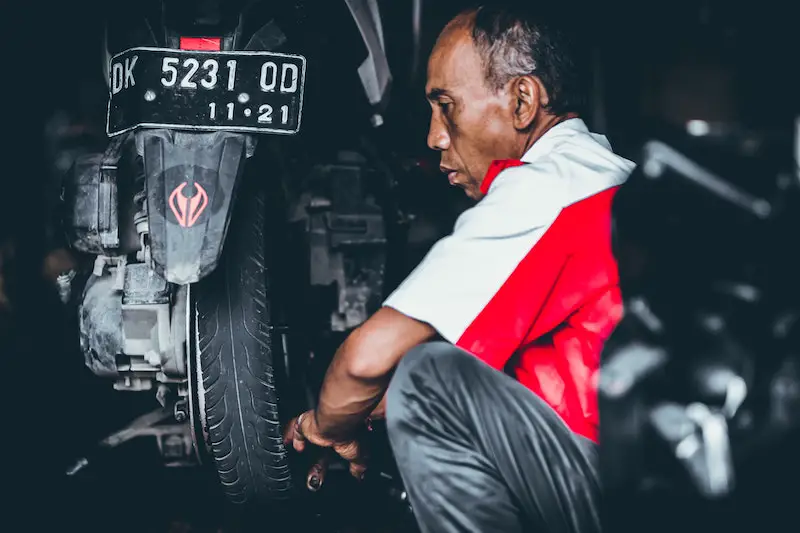
Basic motorcycle maintenance is another skill you will learn as a new rider. If not, you can expect regular expensive visits to your local motorcycle mechanic.
Keeping your bike properly maintained makes it safer for you to ride. It will also extend the lifespan of your motorcycle. A bike that’s maintained can be relied on when you’re out cruising. Neglecting to maintain your bike means you’ll always be worrying about something going wrong.
It’s a good idea to regularly inspect your motorcycle. Check the motorcycle tires, inspect the motorcycle chain, and look at fluid levels.
Look for a components that are damaged, cracked, or broken. If you notice any problems, such as low tire pressure or a chain that needs to be lubed, take care of it right away.
New to riding? Check on our post on the best beginner motorcycles!

